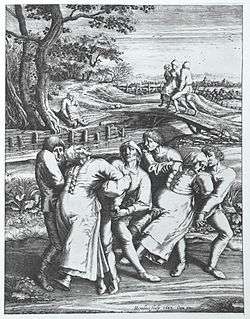Dancing Plague of 1518

The Dancing Plague (or Dance Epidemic) of 1518 was a case of dancing mania that occurred in Strasbourg, Alsace (then part of the Holy Roman Empire) in July 1518. Around 400 people took to dancing for days without rest, and, over the period of about one month, some of those affected died of heart attack, stroke, or exhaustion.
Events
The outbreak began in July 1518, when a woman, Mrs. Troffea, began to dance fervently in a street in Strasbourg.[1] This lasted somewhere between four and six days. Within a week, 34 others had joined, and within a month, there were around 400 dancers, predominantly female. Some of these people eventually died from heart attacks, strokes, or exhaustion.[1] One report indicates that for a period the plague killed around fifteen people per day.[2]
Historical documents, including "physician notes, cathedral sermons, local and regional chronicles, and even notes issued by the Strasbourg city council" are clear that the victims danced.[1] It is not known why these people danced, some even to their deaths.
As the dancing plague worsened, concerned nobles sought the advice of local physicians, who ruled out astrological and supernatural causes, instead announcing that the plague was a "natural disease" caused by "hot blood". However, instead of prescribing bleeding, authorities encouraged more dancing, in part by opening two guildhalls and a grain market, and even constructing a wooden stage. The authorities did this because they believed that the dancers would recover only if they danced continuously night and day. To increase the effectiveness of the cure, authorities even paid for musicians to keep the afflicted moving.[3]
Historian John Waller stated that a marathon runner could not have lasted the intense workout that these men and women did hundreds of years ago.[4]
Modern theories include food-poisoning caused by the toxic and psychoactive chemical products of ergot fungi, which grows commonly on grains in the wheat family (such as rye). Ergotamine is the main psychoactive product of ergot fungi, it is structurally related to the recreational drug lysergic acid diethylamide (LSD-25), and is the substance from which LSD-25 was originally synthesized. The same fungus has also been implicated in other major historical anomalies, including the Salem witch trials. Waller speculates that the dancing was "stress-induced psychosis" on a mass level, since the region where the people danced was riddled with starvation and disease, and the inhabitants tended to be superstitious. Seven other cases of dancing plague were reported in the same region during the medieval era. [5]
See also
References
- 1 2 3 Viegas, Jennifer (1 August 2008). "'Dancing Plague' and Other Odd Afflictions Explained". Discovery News. Discovery Communications. Archived from the original on 13 October 2012. Retrieved 6 May 2013.
- ↑ Waller J (February 2009). "A forgotten plague: making sense of dancing mania". Lancet. 373 (9664): 624–5. doi:10.1016/S0140-6736(09)60386-X. PMID 19238695.
- ↑ Waller, John C. (September 2008). "In a spin: the mysterious dancing epidemic of 1518". Endeavour. Elsevier. 32 (3): 117–121. doi:10.1016/j.endeavour.2008.05.001. ISSN 0160-9327. PMID 18602695.
- ↑ digitaljournal.com/article/258521
- ↑ http://www.digitaljournal.com/article/258521
Further reading
- Backman, Eugene Louis (1977) [1952]. Religious Dances in the Christian Church and in Popular Medicine. Westport, CT: Greenwood Press. ISBN 978-0-8371-9678-7.
- Waller, John (2008). A Time to Dance, A Time to Die: The Extraordinary Story of the Dancing Plague of 1518. Thriplow: Icon Books. ISBN 978-1-84831-021-6.
- Waller, John (2009). The Dancing Plague: The Strange, True Story of an Extraordinary Illness. Naperville, IL: Sourcebooks, Inc. ISBN 978-1-4022-1943-6.
External links
- "Dancing death" by John Waller. BBC News. 12 September 2008.
- "The Dancing Plague of 1518" by Doug MacGowan. Historic Mysteries. 28 June 2011.